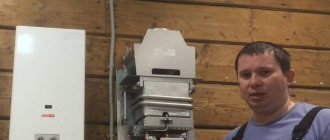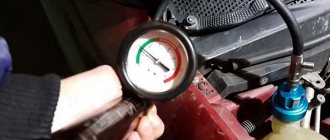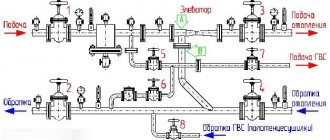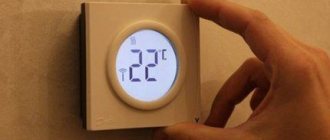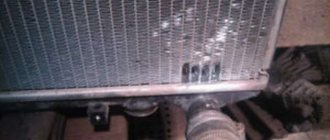Cleaning your air conditioner should not be limited to just caring for the external elements. Dust gets everywhere, accumulates and interferes with the normal operation of mechanisms. You can invite a technician from the service center for maintenance, but many craftsmen cope with this task on their own.
In order to carry out all maintenance work yourself, you need to know the structure of the internal unit of the split system. We will tell you everything about the design of climate control equipment. We will give recommendations according to which it was possible to safely disassemble the unit, clean it and reassemble it again.
Main elements of the indoor unit
Although the design of specific models from different manufacturers varies, the basic diagram by which such climate control equipment is assembled has common basic elements.
The internal block of a modern split system consists of:
- front panel;
- filter elements;
- fan and evaporator;
- engine;
- blinds;
- drainage systems;
- indicator panel, etc.
To properly disassemble the device, you need to carefully disconnect the individual elements in the correct sequence. First, you should carefully study all accompanying documents received when purchasing the device.
Basic structure of the indoor unit: 1- front panel; 2,3 – filters; 4 – fan; 5 – evaporator; 6 – blinds; 7 – panel with indicators; 8 – vertical blinds
In them you can find a lot of useful information on how to disassemble the internal unit of this split system to carry out maintenance activities. If for some reason there is no documentation, it makes sense to search for the necessary information on the Internet.

The mesh filter, designed for primary purification of the air entering the indoor unit, must be regularly cleaned of contaminants using detergent
Samsung AR7500 AR12TXFYAWKNUA GEO
The energy-efficient technology of this model is able to maintain the set temperature without the need to frequently turn the device on and off. There is a fast cooling mode, which is carried out by operating the compressor at maximum power with maximum fan speed for 30 minutes, and then the air conditioner automatically switches to the mode of maintaining the desired temperature. The Care Filter is capable of capturing up to 99% of certain viruses, bacteria and allergens, resulting in cleaner air. When the air conditioner is turned off, the self-cleaning function is activated, which automatically starts the fan to remove dust and moisture in the heat exchanger. The air conditioner also has an anti-corrosion coating, which protects it from rust.
General procedure
First you need to prepare to disassemble the indoor unit: disconnect the device from the network, prepare the necessary tools and materials. You will need various screwdrivers, hexagons, a rag, a container to drain condensation, a stepladder, etc.
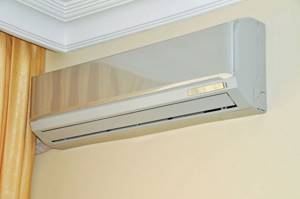
Large air flows constantly pass through the indoor unit of the air conditioner, and dust particles remain inside. You need to periodically remove this debris for the device to work correctly.
Different ]split systems[/anchor] use different types of fastenings: bolts, latches, clips, etc. Particular care should be taken when working with plastic fasteners. Excessive force will cause the element to break. Instead of cleaning the device, it will need to be repaired.
First, remove the front panel of the indoor unit. You will have to unscrew the bolts or disconnect the clips; you can carefully pry them off with a straight screwdriver.
After this, the mesh filter and blinds are removed from the housing. Usually these elements, which need to be cleaned quite often, are simply inserted into the housing. Manufacturers provide the possibility of their easy dismantling.
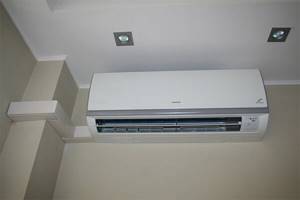
It is important to consider which side the condensate drain tube is connected to. With some Panasonic air conditioners connected to the left, this tube will have to be disconnected to remove the condensate collector
Now you need to find and disconnect the drainage tray, if possible. Sometimes it is built into the body. At this stage, you will need a container for the accumulated liquid, as well as a rag, in case the water spills. In LG air conditioners, such an element is usually attached to one bolt; there are clips located at the bottom; they need to be snapped off.
Then you should remove the impeller shaft. A lot of dust usually accumulates in its grooves. This element is usually removed from the bottom or side. If the design allows, it is preferable to use the first option, it is simpler.
They do it like this:
- Disconnect the radiator mounts located on the left side of the case.
- Loosen the impeller fastening screw on the right.
- Carefully lower the shaft down, holding the loosened bolt with a screwdriver so as not to touch the blades.
All operations must be performed slowly and carefully. The screw that holds the impeller in place is very tight. It must be unscrewed so as not to damage the thread. You don't want to unscrew it all the way because it can be difficult to put it back in exactly the same position.
If it is not possible to remove the shaft from below, you need to use a more complex option:
- Disconnect the wiring from the control unit.
- Remove the fasteners and disconnect the unit from the split system.
- Remove the motor mounts and remove the casing from the shaft.
- Disconnect the shaft and engine by bending the radiator tubes.
- Remove the impeller and clean all elements.
When reassembling the device after cleaning the equipment, it is very important to connect all the elements correctly. The blades of rotating parts must not touch the walls of the housing or other components of the device.
Attention will also be required when connecting the wiring. It is better for inexperienced craftsmen to first draw a diagram or photograph the wires so as not to confuse anything while connecting them.
How is freon discharged?
There are several ways to remove a working air conditioner.
- An ordinary pressure gauge station is used. With its help, all freon is pumped out.
- Using a special station connected to a cylinder with two valves. Such a device pumps out liquid and gaseous freon.
The first option is considered simpler. However, this requires running the air conditioner. But you can do this only if it’s not too cold outside.
The second option is more complicated, but it can be used in almost any situation, even when it’s cold and turning on the air conditioning is prohibited. In addition, this method has another advantage: freon will be completely pumped out of the condenser. Thanks to this, it is possible to transport the air conditioner from place to place.
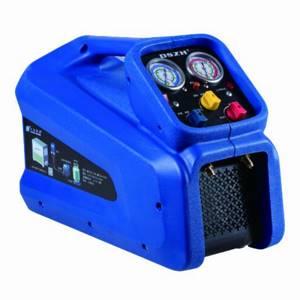
The use of such a station allows for dismantling in winter
Disassembly using the example of a Panasonic air conditioner
Even such a high-quality device with good filters is not protected from dust getting inside the case. The space between the turbine lamellas turned out to be very small here. Dust accumulates in these narrow gaps, which cannot be removed with a standard vacuum cleaner.
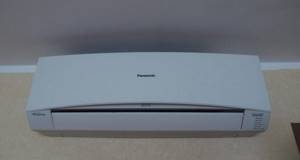
To disassemble the split system, you do not need to completely dismantle the external unit; you can remove only part of its elements while standing on a stepladder
Panasonic has the ability to remove the turbine for cleaning without any problems. Although this is not such a simple procedure as when processing filters. There is no need to remove the housing from the wall; all operations can be performed while standing on a stepladder.
The electronic control unit with indication and other elements of this type are located on the right from the point of view of the master, who stands directly in front of the device. You need to start by disconnecting the case. It has screws on the bottom sides and is held in place with latches on the top.
First you need to unscrew the screws. They are located on the sides and hidden by neat decorative plugs. To find them, the moving part of the body will have to be lifted. Pry off the plugs with a straight screwdriver, then use a Phillips screw to unscrew the fasteners.

In order to disassemble the air conditioner, you need to unscrew the screw, disconnect the condensate collector, then unscrew the screw holding the heat exchanger, then loosen, but do not remove the hidden turbine screw. Finally, you need to lift the heat exchanger and pull out the turbine
Now the case needs to be lifted with a gentle upward movement to disconnect it. There may be a click as it is held in place by three plastic hook latches. Now you can remove another part of the housing, which consists of a cover, a motor and a condensate trap.
This block is attached to grooves located quite deep in the body, but can be easily removed. You need to carefully pull it down with moderate force. If the entire block does not separate at once, you can first release the fastening on the left, and then on the right.
At this stage, you need to pay attention to the position of the hose through which the condensate is discharged. If it interferes (this happens when connected on the left side), then it must first be disconnected from the condensate collector.
The moisture container is not completely separated from the body, since it is additionally connected to it with a pair of thin wires. You need to take care of a stand for this part of the air conditioner in advance or hang it on a cord, rope, etc.
The weight of the condensate collector may cause the wiring to break. As previously mentioned, at this stage accumulated condensate may spill out. It is better to immediately pour the moisture into a suitable container. It's very likely that some of the water will spill, so it's best to keep a rag handy.
You will learn about what should be done if HVAC equipment constantly leaks into the room it treats from the following article, which we strongly recommend reading.
The removed condensate collector will provide access to the technical contents of the unit: on the left, the head of the screw securing the heat exchanger and the rubber bearing of the turbine will become visible. The screw needs to be unscrewed, but the bearing should not be touched; it must remain in the grooves that hold it.
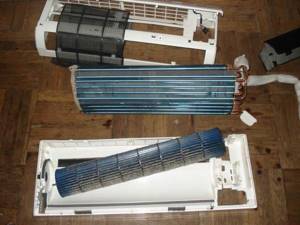
If the split system has not been cleaned for a long time, dust accumulates on its internal elements, and mold also appears, which is dangerous to the health of residents.
Now you need to rotate the turbine with your hands to find the place on its right side where it is secured with a screw on the engine shaft. One lamella is missing here. The screw is recessed deep. It needs to be unscrewed, but should not be removed to facilitate reassembly. After this, lift the heat exchanger with moderate force.
It is secured with latches and you should hear a click. Here you need to act carefully so as not to cut yourself, the edges of some parts are quite sharp. When the heat exchanger comes out of the latches and is lifted, a vertical gap will appear through which you can carefully remove the turbine, after first removing the bearing.
Consequences of improper dismantling
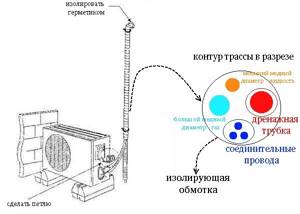
If dismantled incorrectly, it is easy to damage the air conditioner. Possible unpleasant consequences:
- Depressurization of the cooling circuit, which entails a freon leak. When installing the device later, you will have to pay extra to refill the system with refrigerant.
- Mechanical damage to the casing of the outdoor unit, freon pipes, and other parts.
- Cooling circuit clogged with debris, moisture penetration. When dust gets in, the compressor wears out faster. Water can oxidize the surface of the copper freon pipe, causing the entire system to fail.
- The outdoor unit falls from a height. The installation height of the module is not important - after it falls, it will have to be replaced in any case.
The air conditioner is usually dismantled when changing place of residence, during repairs and cleaning. When disassembling simple units, you do not have to understand their structure. However, full-fledged split systems require a careful approach. Since the equipment is expensive, it is better to turn to professional installers who will perform the work efficiently and with a guarantee. You can disassemble the device yourself only if you are fully confident in understanding its structure.
A few words about cleaning
After completing disassembly of the indoor unit, it is recommended to carry out dry cleaning. To do this you need a household vacuum cleaner and a brush.
They operate simultaneously: use a brush to treat the available space, and keep the edge of the hose of the turned on vacuum cleaner nearby to immediately remove debris. Some people treat the insides of the unit with dry steam if they have access to a steam generator.
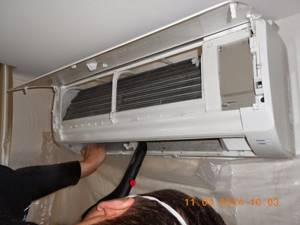
After all elements that can and should be washed have been removed from the indoor unit, it should be cleaned using a household vacuum cleaner
You can then use a cleaning agent, for example in the form of an aerosol. It is kept for some time, you need to act according to the instructions. Then the surface is treated with clean water using a brush or spray bottle to remove the cleaning agent that has dissolved the dirt. You will need a container to collect the draining water.
Now you need to wash the turbine, filters and other elements and dry them. This can be done using common home remedies, but there are convenient kits available for this purpose. Then the device is reassembled. All fasteners must be in place and carefully tightened or latched.
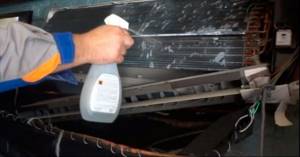
Special products designed for cleaning climate control equipment can effectively dissolve accumulated contaminants. After the allotted time, the composition should be carefully washed off.
Parts removed from the device can be washed with hot water and treated with a brush. There are household chemicals specifically designed for such equipment. But regular laundry soap will give good results. Of course, you need to protect parts from damage.
For example, hard bristles can seriously damage the mesh filter. A lot of dust accumulates on the impeller; every groove needs to be processed. All filter elements are thoroughly washed. They should be dried before installation.
The surface of the evaporator and rotor, as well as the condensate container, are treated especially carefully. It doesn’t hurt to check the condition of the tube through which moisture escapes. If you clean it with a piece of rigid cable, you can find serious dirt there. They are simply pushed out and the tube is washed out.

A special kit for cleaning air conditioners consists of a large plastic bag of a convenient size and a set of devices that give it the desired position
Some craftsmen decided to abandon disassembling the indoor unit. They remove only the front cover and filter, and then cover the wall with polyethylene and rinse the indoor unit with a thin stream of water under high pressure. This is not the best solution, since you can break the air conditioner and damage the decorative finish.
If cleaning measures do not give the expected result, full functionality of the split system is not restored, the air conditioning unit will have to be repaired. You will find repair instructions in our recommended article.
Precautions
If the air conditioner is out of order and cannot be repaired, then it is easy to remove it - there is no need to save freon, the tightness of the compressor, condenser and evaporator is not important.
You cannot do this with a working air conditioner. And in this case, the main thing is that dust and even air do not get inside the system. Otherwise, we can talk about guaranteed compressor output after installation and start-up of the air conditioner in a new location. The reason is the design feature of the vacuum pump.
Freon is extremely fluid, and the temperature difference at the inlet and outlet reaches several tens of degrees. None of the seals and rings used in conventional pumps and compressors will withstand such operating conditions. The required tightness is achieved through extremely precise adjustment of the surface of the moving elements of the pump to the internal geometry of the chambers. The slightest scratch from a solid particle leads to compressor failure. And such a particle could be a grain of ice formed when moisture in the air trapped inside freezes.
That is why new air conditioners are sold filled with inert gas, which is pumped out with a vacuum pump before pumping in freon.
When removing the air conditioner yourself, the freon must be pumped out and the units disconnected. This must be done so that dust and air do not get inside the system. That is, create a vacuum there. And it is advisable to save all the freon (or most of it) so that it would be easier to get the system into working condition in a new place.
Preparation
To properly remove the air conditioner, the only professional equipment you need is a pressure gauge station, which can be rented.
Every home craftsman has the remaining tools:
- a set of wrenches and hex keys;
- screwdrivers;
- pipe cutter or side cutters;
- hand bench vice;
- pliers.
Freon release
There are two ways to dismantle a working air conditioner:
- Using a pressure gauge station to collect freon in an external unit.
- Using a freon pumping and collection station connected to a special two-valve cylinder. The station has its own pressure gauge manifold and a compressor for pumping out refrigerant in liquid or gaseous state.
The first method is more “affordable”, but it can only be used when starting the air conditioner - freon is transported using a standard compressor.
The second method is universal. It can be used even in winter, when the air conditioner cannot be turned on due to low outside temperatures. The advantage of this method is that the external unit will be evacuated - without freon in the condenser. Which is much safer when transporting to a new place. But renting such a station and a cylinder will cost more than a regular pressure gauge manifold.
Conclusions and useful video on the topic
How to disassemble the indoor unit:
To perform such disassembly requires attention, time and patience. The procedure does not require complex instruments or special skills. But inattention during operation is unacceptable, since this can completely ruin the split system.
Would you like to tell us about how you cleaned the internal components of the climate control unit with your own hands? Do you have useful information that will be useful to site visitors? Please leave comments in the block below, ask questions, post photos on the topic of the article.
How to disassemble and clean your home air conditioner yourself

Antibacterial treatment and cleaning of the existing split system must be performed annually. Let us clarify: we are talking about internal modules used in your home, and office units need to be washed even more often. Maintenance of the external unit is carried out as it gets dirty, but at least once every 2 years. Let's figure out how you can clean your home air conditioner without calling a service technician, that is, with your own hands.

